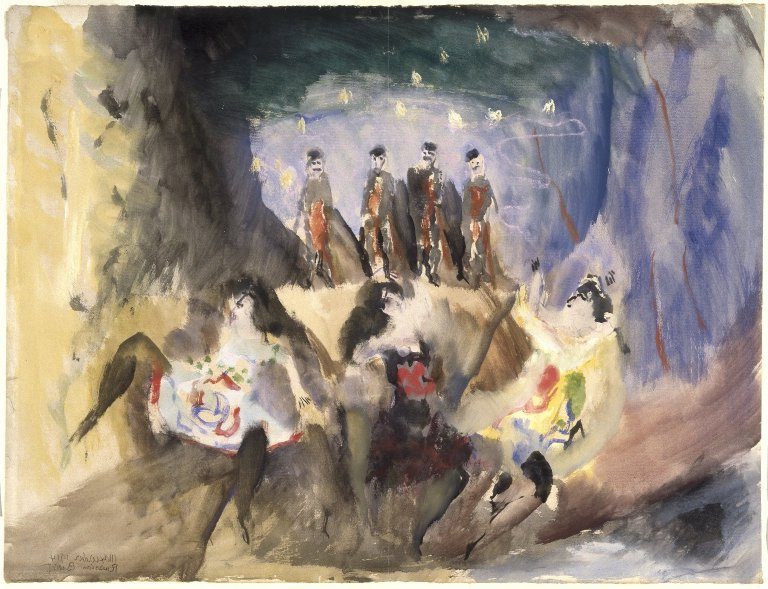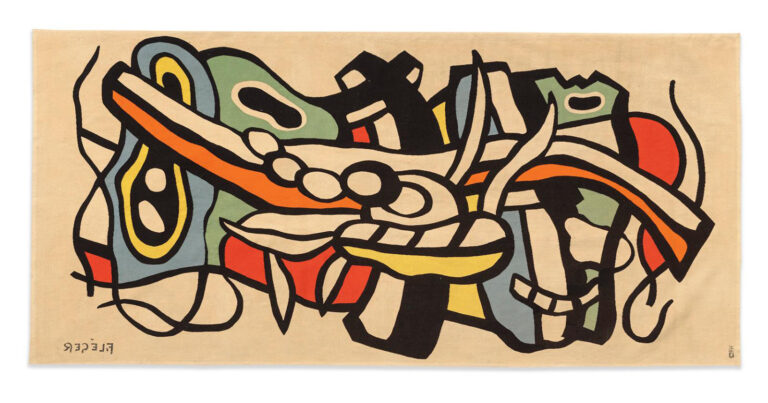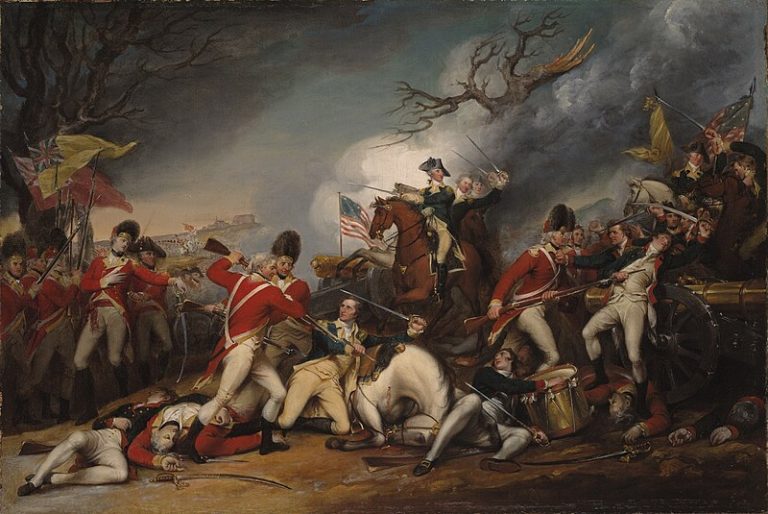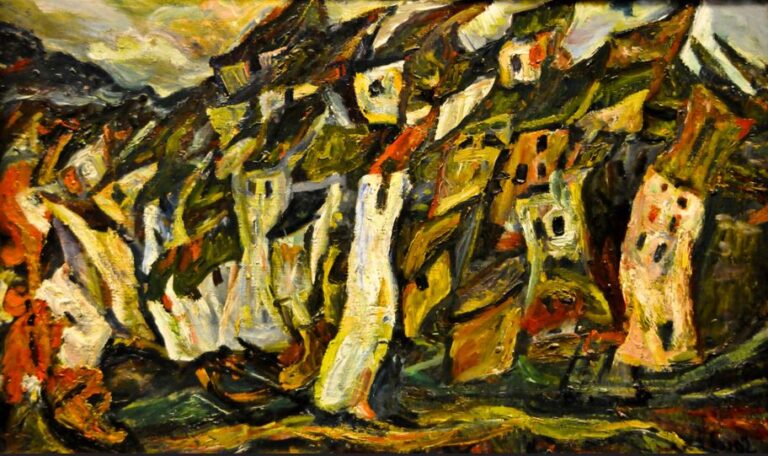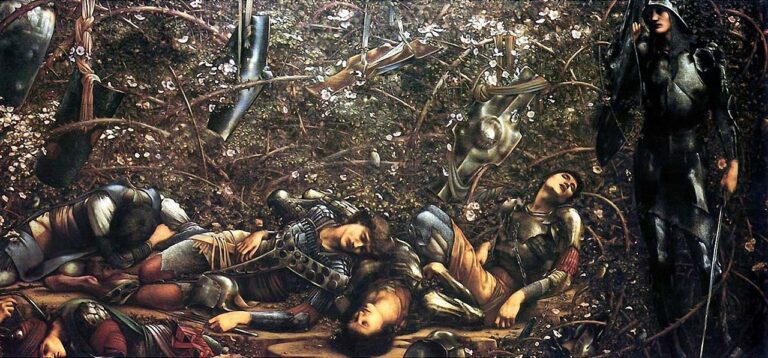Edward Ruscha Painter: A Pioneering Force in Contemporary American Art
Born: December 16, 1937, Omaha, Nebraska, U.S.
Art Movement: Pop Art
Nationality: American
Teachers: Robert Irwin and Emerson Woelffer
Institution: California Institute of the Arts
Edward Ruscha Painter: A Pioneering Force in Contemporary American Art
Early Life and Career
Edward Ruscha began his career in the American Midwest before moving to California, where his distinctive artistic voice would develop. His early years laid the foundation for his later exploration of American culture through various artistic media.
Beginnings in Omaha, Nebraska
Edward Joseph Ruscha IV was born on December 16, 1937, in Omaha, Nebraska. He spent his early childhood there before his family relocated to Oklahoma City in 1941. This Midwestern upbringing would later influence his artistic perspective on American landscapes and culture.
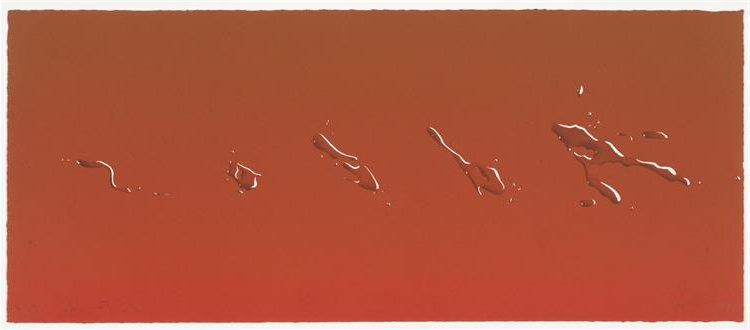
Adios, 1969, by Edward Ruscha
In Oklahoma City, Ruscha showed early signs of artistic talent. He enrolled in his first formal painting class with portrait artist Richard Goetz in 1948, while still in elementary school. This early exposure to art training helped shape his developing skills.
During his high school years, Ruscha continued to study art, developing both technical abilities and a growing interest in commercial art and design. In 1956, after finishing high school, he made a pivotal decision that would change the course of his life.
Chouinard Art Institute Training and Influences
In 1956, Ruscha drove along the iconic Route 66 from Oklahoma to Los Angeles, California. This journey later became a significant theme in his work, reflecting his fascination with the American landscape and roadside culture.
Upon arriving in California, Ruscha enrolled at the prestigious Chouinard Art Institute (now CalArts). There, he studied commercial art and design, developing skills that would later inform his distinctive artistic style. His education at Chouinard exposed him to various artistic movements and techniques.
During this period, Ruscha was influenced by the work of Jasper Johns, Marcel Duchamp, and Robert Rauschenberg. He also became associated with the Ferus Gallery group, connecting him to the emerging Los Angeles art scene of the late 1950s and early 1960s.
The Start of a Printmaking and Painting Voyage
Ruscha began his professional artistic career in the early 1960s, quickly developing his signature style that combined text and image. His first solo exhibition was held at the Ferus Gallery in 1963, marking his emergence as a significant figure in contemporary art.
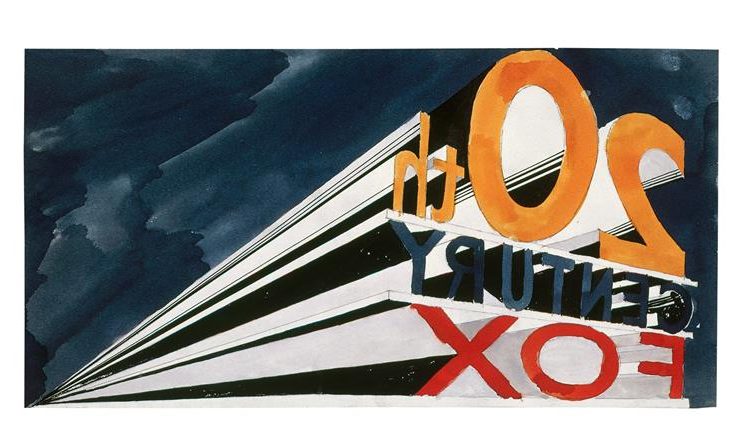
20TH CENTURY FOX, 1962, by Edward Ruscha
In these early years, Ruscha experimented with various media, including painting, drawing, and printmaking. He created his first artist’s book, “Twentysix Gasoline Stations” in 1963, documenting service stations along Route 66 between Los Angeles and Oklahoma City.
His early paintings featured bold text against monochromatic backgrounds, often incorporating references to American pop culture and the urban landscape of Los Angeles. Works like “OOF” (1962) and “Boss” (1961) showcased his interest in words as both visual elements and carriers of meaning.
Artistic Themes and Techniques
Edward Ruscha developed distinctive artistic approaches that blend visual art with language. His work explores American culture through unexpected juxtapositions of words and images, often with deadpan humor and precise technical execution.
Incorporation of Vernacular and Typography
Ruscha’s most recognizable technique involves the transformation of ordinary words into powerful visual statements. He elevates everyday language by treating text as both subject and object within his compositions. Words appear against gradient skies, landscapes, or monochromatic backgrounds in carefully selected typefaces.
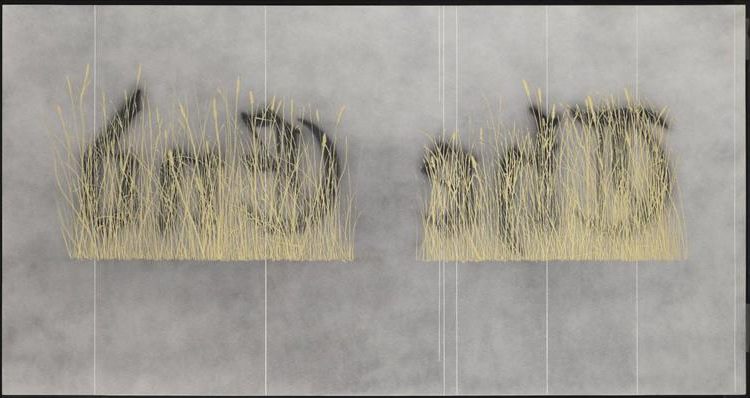
The Final End, 1992, by Edward Ruscha
In pieces like “Annie, Poured from Maple Syrup,” Ruscha uses trompe l’oeil techniques to give text physical properties, making words appear as if formed from liquid. This approach highlights the artificial nature of both language and painting.
His word paintings often feature short phrases, single words, or onomatopoeic sounds that challenge viewers to reconsider the relationship between visual and verbal communication. Typography becomes a central element rather than just serving a descriptive purpose.
Los Angeles and Pop Art Inspirations
The urban landscape of Los Angeles profoundly shaped Ruscha’s artistic vision. His famous photo book “Twentysix Gasoline Stations” (1963) documented mundane roadside architecture along Route 66, celebrating ordinary American scenes typically overlooked in fine art.
Ruscha captured the essence of Los Angeles through its distinctive visual elements: gas stations, apartment buildings, parking lots, and the Hollywood sign. These subjects reflect his interest in the banality of modern urban life and the commercial landscape of Southern California.
As a key figure in West Coast Pop Art, Ruscha’s work examines themes of consumerism and the American Dream. Unlike his East Coast contemporaries, his approach maintains a certain detachment and cool observation rather than outright critique or celebration.
Experimentation in Film, Drawing, and Photography
Beyond painting, Ruscha worked extensively in multiple media. His photographic books document subjects like “Every Building on the Sunset Strip” with a straightforward, almost scientific approach that influenced conceptual photography.
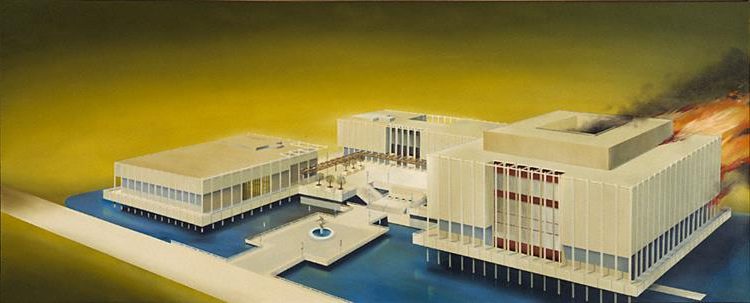
The Los Angeles County Museum on Fire, 1965–1968, by Edward Ruscha
His drawings often employ unconventional materials like gunpowder, blood, and food items. These experimental techniques create unique textures and challenge traditional notions of what constitutes art materials.
Ruscha’s short films, including “Premium” (1971), extend his artistic vision into moving images while maintaining his characteristic deadpan humor and focus on ordinary objects and scenarios. His cross-media approach demonstrates his willingness to explore ideas through whatever medium best serves his concept.
Notable Works and Impact
Ed Ruscha’s art transformed everyday American scenes into iconic works that blend imagery and text. His distinctive style captured the essence of Los Angeles and American culture while influencing generations of artists with his conceptual approach and deadpan humor.
Famous Series: Gas Stations and the Sunset Strip
Ruscha’s breakthrough came with “Twentysix Gasoline Stations” (1963), a photo book documenting service stations along Route 66 between Los Angeles and Oklahoma. This seemingly mundane subject matter revolutionized conceptual art with its detached documentation of American infrastructure.
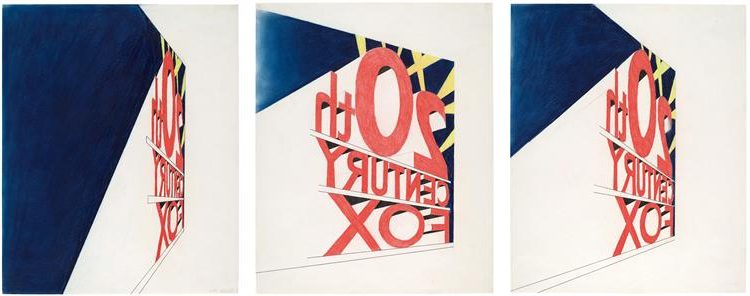
View of the Big Picture, 1963, by Edward Ruscha
His landmark “Every Building on the Sunset Strip” (1966) continued this approach, presenting a continuous accordion-folded panorama of Los Angeles’ famous boulevard. The methodical documentation showed both sides of the street with no artistic flourishes.
Ruscha’s gas station paintings, particularly “Standard Station” (1966), became some of his most recognizable works. These pieces elevated ordinary structures into archetypal American landscapes through bold colors and dramatic perspectives.
Cultural Representation in Art
Ruscha’s work captures quintessential American life through its focus on the overlooked aspects of the urban environment. His paintings feature Hollywood logos, apartment buildings, and commercial signage that reflect Los Angeles’ unique visual language.
Text plays a crucial role in Ruscha’s art. Works like “OOF” (1962) and “HONK” (1962) isolate single words against solid backgrounds, creating tension between appearance and meaning. These pieces explore how words function as both visual elements and carriers of meaning.
Ruscha’s playful humor appears in works like “Pay Nothing Until April” (2003), where text floats across mountain landscapes. This juxtaposition of commercial language with natural beauty creates unexpected commentary on American consumer culture.
Legacy and Influence on American Art
Ruscha’s influence extends across contemporary art, photography, and graphic design. His conceptual approach to documenting ordinary subjects helped establish photography as a legitimate artistic medium beyond traditional portraiture and landscapes.
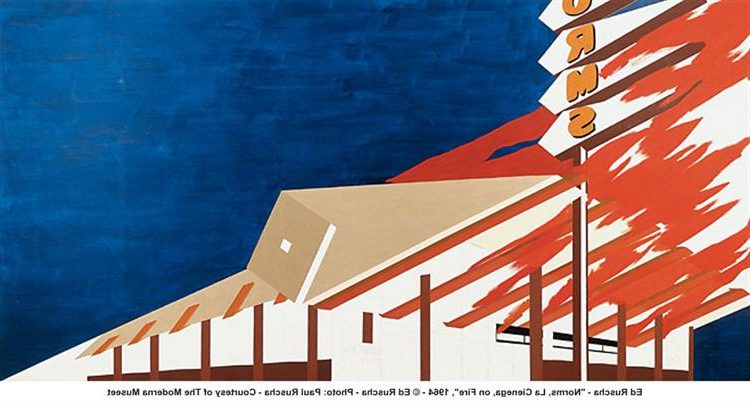
Norms, La Cienega on Fire, 1964, by Edward Ruscha
Major institutions like the Los Angeles County Museum of Art have held significant retrospectives of Ruscha’s work. In 2018, his painting “Hurting the Word Radio #2” sold for $52.5 million, demonstrating his enduring market value.
Ruscha’s graphic simplicity and integration of text with image influenced generations of artists and designers. His deadpan documentation of the American landscape created a visual vocabulary that continues to resonate in contemporary art.
Frequently Asked Questions
Ed Ruscha’s work inspires many questions from art enthusiasts and critics alike. These common inquiries explore his themes, techniques, and contributions to the art world.
What are the main themes in Ed Ruscha’s paintings?
Ed Ruscha frequently explores the American landscape and consumer culture in his paintings. His work often features gas stations, parking lots, and elements of the Los Angeles urban environment.
Words and text appear regularly in his art, creating tension between image and language. He transforms ordinary phrases by isolating them against gradient backgrounds or landscapes.
Ruscha’s paintings frequently comment on the banality of everyday life and American commercial culture. His deadpan humor and detached perspective give his observations about modern life a distinctive quality.
How has Ed Ruscha contributed to contemporary art?
Ruscha helped bridge Pop Art and Conceptualism, influencing generations of artists. His artist books from the 1960s, like “Twentysix Gasoline Stations,” revolutionized the format and inspired countless artists.
His word paintings established a new approach to text in visual art. Ruscha’s work with photography and printmaking expanded the possibilities for these mediums in fine art.
His distinct visual style has influenced graphic design, typography, and visual communication beyond traditional art spheres.
What techniques does Ed Ruscha employ in his prints and paintings?
Ruscha often swaps traditional materials like oil paint for unconventional substances. He has used organic materials including food items, bodily fluids, and even gunpowder in his work.
His printmaking techniques are equally innovative, exploring silkscreen, lithography, and etching. Ruscha is known for his precise application of color, particularly in his gradient backgrounds.
His technical approach creates a polished, almost commercial aesthetic that contrasts with his often mysterious or ambiguous content.
Can you provide an overview of Ed Ruscha’s involvement with LACMA?
Ed Ruscha has had a long relationship with the Los Angeles County Museum of Art (LACMA). The museum has hosted several major retrospectives of his work over the decades.
Ruscha has donated significant works to LACMA’s permanent collection. His connections to Los Angeles make him particularly important to this institution that represents the city’s art scene.
The museum has documented much of Ruscha’s career through exhibitions, catalogs, and public programs about his art.
How has Ed Ruscha’s background influenced his artistic style?
Born in Nebraska but raised in Oklahoma, Ruscha moved to Los Angeles to study at the Chouinard Art Institute. This Midwestern perspective on California culture gives his work a unique outsider-insider viewpoint.
His early training in commercial art and graphic design shaped his clean aesthetic and interest in typography. Working in a commercial printing shop gave him technical knowledge that influenced his approach to text and image.
The car culture and sprawling landscape of Los Angeles became central themes in his work after settling there in the early 1960s.
What are some of the most iconic artworks created by Ed Ruscha?
“OOF” (1963) features the word “OOF” in bold yellow letters against a blue background. This showcases his signature text-based approach.
“The Music from the Balconies” (1984) overlays text on a sunset landscape. This creates tension between words and image.
“Standard Station” (1966) depicts a gas station at an angle, becoming one of his most recognized images. His “Hollywood” sign paintings capture the mythology of Los Angeles in his distinctive style.
“Every Building on the Sunset Strip” (1966) documented an entire street in a folding book format. This revolutionized how photography could be used in art.



